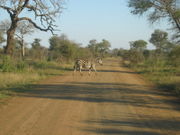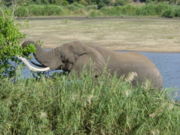1.2.2. Apply WebPark
 Image from Wikipedia Image from Wikipedia |
 Image from Wikipedia Image from Wikipedia |
WebSafari
In this activity you should discuss within a small group how you would apply the WebPark model to a new park with its own unique conditions. Feel free to draw the applications you come up with as a 'storyboard'. In this activity we will consider the example of the famous Kruger National Park in South Africa. The Kruger national park covers 18,989 sq kms of north-west South Africa (Wikipedia). It is famous for its diverse landscapes and rich variety of wildlife including the so called "Big Five"; Lions, Elephants, Buffalo, Leopard, and Rhinoceros. Visitors stay overnight in the reserve usually moving between the various rest camps. Movement around the park is strictly by car. Visitors may not leave their vehicles except at a few designated points or if accompanied by an armed guide. The reasons for this should be obvious! Have a look at the Kruger national park website to identify types of data and activities that that might be included in the WebSafari system. In addition look at the public sighting information such as the sightings maps of the big five and the sightings gallery. Think about how this information could also be included and managed in you system. Review the following questions:
- How do your ideas extent beyond those found in WebPark? (for example, you might focus more on sighting information from visitors, on providing management functions, or on providing real time data.)
- What additional information would you need to find in WebPark? (for example accomodation)
- How do the constraints of Kruger affect your ideas for the service? (for example visitors needing to stay in their cars)
